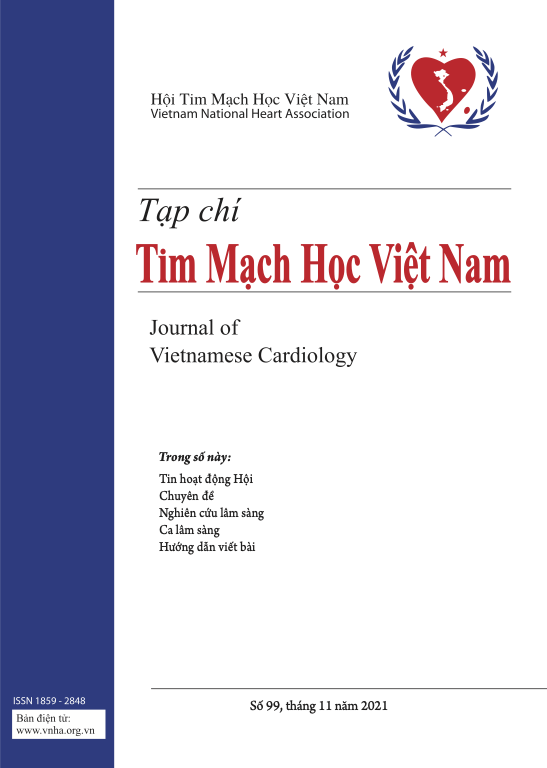Vai trò độc lập của thang điểm PESI giản lược trong tiên lượng tử vong 30 ngày ở bệnh nhân tắc động mạch phổi cấp
Tóm tắt
Thang điểm sPESI là yếu tố dự báo tử vong sớm cho bệnh nhân tắc động mạch phổi cấp (TĐMP) và được sử dụng thuận tiện và dễ dàng tại các đơn vị hồi sức. Nghiên cứu này nhằm tìm hiểu vai trò độc lập của sPESI trong tiên lượng tử vong 30 ngày TĐMP tại Việt Nam.
Phương pháp: 162 bệnh nhân tại hai bệnh viện khác nhau được lựa chọn vào nghiên cứu. Thang điểm sPESI được tính tại ngay thời điểm nhập viện. Kết cục chính quan sát là tử vong trong vòng 30 ngày kể từ thời điểm nhập viện. Đường cong ROC, độ nhạy, độ đặc hiệu của thang điểm được đánh giá. Kết quả: 29 trong số 162 bệnh nhân đã tử vong trong vòng 30 ngày nhập viện. Điểm sPESI cao hơn ở nhóm tử vong so với nhóm sống (2,10 ± 0,19 với 1,02 ± 0,89, p=0.000), độ nhạy (93%) cũng như giá trị dự đoán âm tính (96%) cao trong tiên lượng tử vong sớm ở các bệnh nhân TĐMP. Trong mô hình hồi quy logistic đa biến, nguy cơ cao với sPESI ≥ 1 làm tăng nguy cơ tử vong gấp 6,28 lần.
Kết luận: Thang điểm sPESI có vai trò độc lập trong dự đoán kết cục tử vong 30 ngày ở các bệnh nhân TĐMP.
Từ khóa: sPESI, tử vong, tắc động mạch phổi, thuyên tắc phổi, Việt Nam..
Tài liệu tham khảo
1. StavrosKonstantinides,AdamTorbicki,GiancarloAgnellietal(2014). 2014 ESC Guidelines on the diagnosis and management of acute pulmonary embolism. European Heart Journal,
![]()
2. JacquesDonzé,GrégoireLeGal,MichaelJ.Fineetal(2008). Prospective validation of the Pulmonary Embolism Severity Index. Thromb Haemost, 100(5), 943-948.
![]()
3. Carlo Bova, Olivier Sanchez, Paolo Prandoni et al (2014). Identification of intermediate-risk patients with acute symptomatic pulmonary embolism. Eur Respir J, 44(3), 694-703.
![]()
4. RMSubramaniam,JMandrekar,DBlairetal(2009). The Geneva prognostic score and mortality in patients diagnosed with pulmonary embolism by CT pulmonary angiogram. JMedImagingRadiatOncol, 53(4), 361-365.
![]()
5. DrahomirAujesky,ScottObrosky,RoslynA.etal(2005). Derivation and Validation of a Prognostic Model for Pulmonary Embolism. AmJRespirCritCareMed, 172(8), 1043-1046.
![]()
6. David Jime´nez, Drahomi Aujesky, Lisa Moores et al (2010). Simplifcation of the pulmonary embolism severity index for prognostication in patients with acute symptomatic pulmonary embolism. Arch Intern Med, 170(15), 1383-1389.
![]()
7. M. Righini, M. Roy, G. Meyer et al (2011). The Simplified Pulmonary Embolism Severity Index (PESI): validation of a clinical prognostic model for pulmonary embolism. Letter to the Editor, 2115 - 2117.
![]()
8. HoàngBùiHải,ĐỗDoãnLợi,Nguyễn Đạt Anh (2014). So sánh mô hình PESI kinh điển và mô hình PESI giản lược để tiên lượng tử vong trong tháng đầu tiên do tắc động mạch phổi cấp. Tạp chí Nghiên cứu Y học, 91(5), 42-46.
![]()
9. YaqingMa,YiminMao,XuegaiHeetal(2016). The values of neutrophil to lymphocyte ratio and platelet to lymphocyte ratio in predicting 30 day mortality in patients with acute pulmonary embolism. BMC Cardiovascular Disorders, 16, 1-6.
![]()
10. MareikeLankeit,DavidJime´nez,MaciejKostrubiecet al (2011). Predictive Value of the High-Sensitivity Troponin TAssayand the Simplified Pulmonary Embolism Severity Index in Hemodynamically Stable Patients With Acute Pulmonary Embolism. Circulation, 124, 2716-2724.
![]()
11. JerrettK.Lau,VincentChow,AlexBrownetal(2017). Predicting in-hospital death during acute presentation with pulmonary embolism to facilitate early discharge and outpatient management. Researcharticle, 12(7), 1-13.
![]()
12. OsamaMukhtar,OdayAlhafidh,MazinKhalidetal(2018). Predictors of hospital stay in normotensive acute pulmonary embolism: a retrospective pilot study. Journalofcommunityhospitalinternalmedicinepespectives, 8(3), 95-100.
![]()
Tải xuống
Đã Xuất bản
Các phiên bản
- 06-03-2023 (2)
- 06-03-2023 (1)








